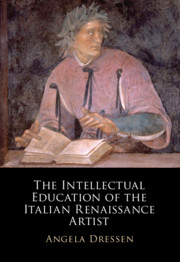Book contents
- The Intellectual Education of the Italian Renaissance Artist
- The Intellectual Education of the Italian Renaissance Artist
- Copyright page
- Contents
- Illustrations
- Preface
- Introduction
- One Mechanical Arts versus Liberal Arts and Recommendations for the Artist’s Education
- Two Educational Places and Opportunities
- Three The Mediating Texts
- Four Vitruvius and Pliny as Sourcebooks, Educational Landmarks, and Intellectual Challenge
- Conclusion
- Book part
- Selected Bibliography
- Index
Conclusion
Published online by Cambridge University Press: 28 August 2021
- The Intellectual Education of the Italian Renaissance Artist
- The Intellectual Education of the Italian Renaissance Artist
- Copyright page
- Contents
- Illustrations
- Preface
- Introduction
- One Mechanical Arts versus Liberal Arts and Recommendations for the Artist’s Education
- Two Educational Places and Opportunities
- Three The Mediating Texts
- Four Vitruvius and Pliny as Sourcebooks, Educational Landmarks, and Intellectual Challenge
- Conclusion
- Book part
- Selected Bibliography
- Index
Summary
The intellectual education of the Renaissance artist turns out to have been a personal enterprise until well into the second half of the sixteenth century. Institutionalized intellectual learning on a broader scale was available for the artist only from the time onward that we nowadays call Late Renaissance and the era of mannerism. At this time, artists benefited from all relevant ancient literature being available in translation, from public lectures on relevant topics, and from an institutionalized education that comprised mathematics, geometry, perspective, anatomy, literature, and drawing. Consequently, the artist developed a new self-confidence in finally being able to participate in learning as a quasi-erudite person: he could follow his own choices with regard to literature, and he concentrated on his own style as his personal manner of expression rather than on the accessibility of literary sources, which had now become almost the same for everyone (below the real academic level). Art moved away from being philology and became rhetoric. The concentration on disegno and style, the competitions among the visual arts, and the fact that the artist determined himself through his personal mode of expression added to this phenomenon.
- Type
- Chapter
- Information
- The Intellectual Education of the Italian Renaissance Artist , pp. 322 - 340Publisher: Cambridge University PressPrint publication year: 2021



